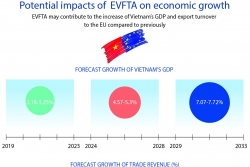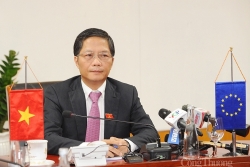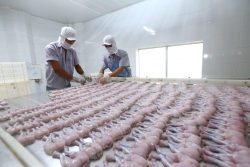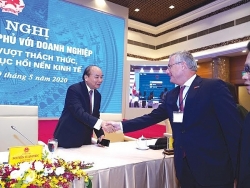
Capitalizing on EVFTA sure to be a challenge: Insiders
Latest
| TIN LIÊN QUAN | |
| Pathway for local businesses to benefit from EVFTA and EVIPA | |
| EVFTA to benefit Vietnam’s agricultural sector: EP official | |
 |
| A garment factory in My Hao district of Hung Yen province. (Photo: VNA) |
Vu Duc Giang, Chairman of the Vietnam Textile and Apparel Association (VITAS), said the National Assembly’s ratification of the EVFTA on June 8 is “good news” for the sector, which has suffered from COVID-19 in recent times, as businesses will have opportunities when the agreement takes effect.
The EU is currently the world’s largest importer of textiles and garments, with 34 percent of the global total each year worth more than 250 billion USD in value. Vietnamese products account for just 2.7 percent of the EU’s imports.
Giang said companies in the sector believe in the prospect of exports to the EU rising after the EVFTA comes into effect, as tariffs will be slashed to zero percent.
Textile and garment shipments to the market are forecast to increase sharply from now to 2025, by about 67 percent compared to a non-EVFTA scenario.
However, the VITAS chairman noted, businesses need to be thoroughly prepared to make use of the opportunities and have a solid grasp of the regulations within the agreement, because the EU is a demanding market with strict requirements on product quality and design.
 | Potential impacts of EVFTA on economic growth |
Just one simple fault may damage all export activities, he said, explaining that a batch of goods with unclear origin or indeterminate quality may expose similar batches to stricter inspections or even an import ban.
Phi Viet Trinh, General Director of the Ho Guom Garment JSC, said that in order to benefit from the preferential tariffs under the EVFTA, products must have a certain proportion of materials hailing from the EU or Vietnam. This is a major challenge because most input materials in Vietnam are currently imported from China or other ASEAN countries.
Therefore, management agencies and businesses alike must take certain action to maximise the opportunities, he stressed.
The official added that it is necessary to promulgate policies to attract domestic and foreign investment in material production. Mechanisms in particular are needed to promote links between material suppliers and manufacturers of finished products to meet rules of origin requirements.
Of a similar mind, General Director of the Garment 10 Corporation Than Duc Viet said the EVFTA will open up numerous opportunities but Vietnam must work hard to fully benefit.
The EU is ready to import Vietnamese goods but such products must comply with rules of origin, he noted, voicing a hope that the textile and garment industry can grasp the available opportunities.
| Read more |
 Minister Tran Tuan Anh: EVFTA hoped to take effect on August 1 Minister Tran Tuan Anh: EVFTA hoped to take effect on August 1 |
Nguyen Quoc Tuan from Vinh Thong Co. Ltd, a footwear exporter to Europe, said the company’s operation has been hindered by COVID-19 since the beginning of the year but now he expects the EVFTA will boost exports over the remainder of 2020.
Nevertheless, he also acknowledged that the company will encounter a range of difficulties in adhering to the agreement’s rules of origin, as while 60 percent of its input materials come from domestic suppliers the remainder comes from elsewhere, primarily China. Updating technology and expanding production scale is also problematic given that the company’s internal resources remain modest.
Nguyen Van Khanh, Vice Chairman and Secretary-General of the Shoe and Leather Association of HCM City, said local leather and footwear enterprises should try and immediately put the EVFTA into full use despite up to 85 percent of them lacking capital, technology, and materials.
It is also not easy to meet rules of origin requirements when 60 percent of materials are from China and other suppliers, he added.
Experts predict that in the short term, the EVFTA may not give a strong boost to the textile - garment and leather - footwear industries in Vietnam, but will certainly bring about long-term benefits for them in expanding their market share in the EU.
A number of enterprises have also voiced hope that when foreign investors realize that Vietnam now has even greater potential, technology transfer and investment in material production will grow.
 | EVFTA a golden opportunity for Vietnam to recover its economy: Analysts The EU-Vietnam Free Trade Agreement (EVFTA) and the Investment Protection Agreement (EVIPA), which were ratified by the National Assembly on the morning of June 8, ... |
 | EVFTA ratification is a 'win-win' for Europe and Vietnam: EuroCham Chairman TGVN. Welcoming the ratification of the EU-Vietnam Free Trade Agreement (EVFTA) EuroCham Chairman Nicolas Audier said that, the agreement represents a true ‘win-win’ not just ... |
 | Foreign expert analyzes 'secret' for losers in the EVFTA game TGVN. As the EU-Vietnam Free Trade Agreement (EVFTA) is about to be ratified by the Vietnam National Assembly, RMIT University (Vietnam) International Business Program Manager ... |














